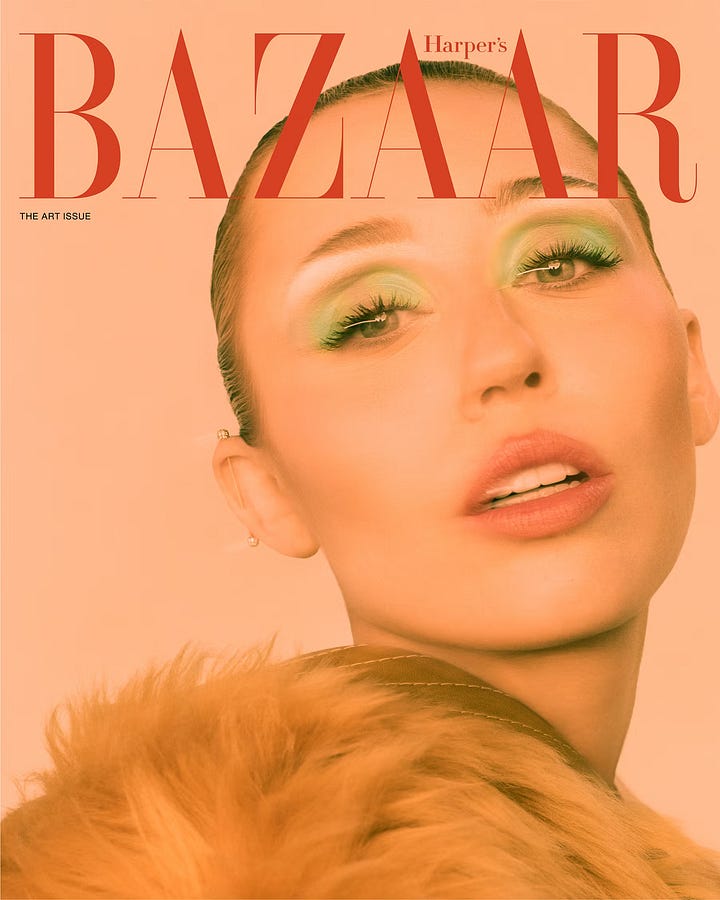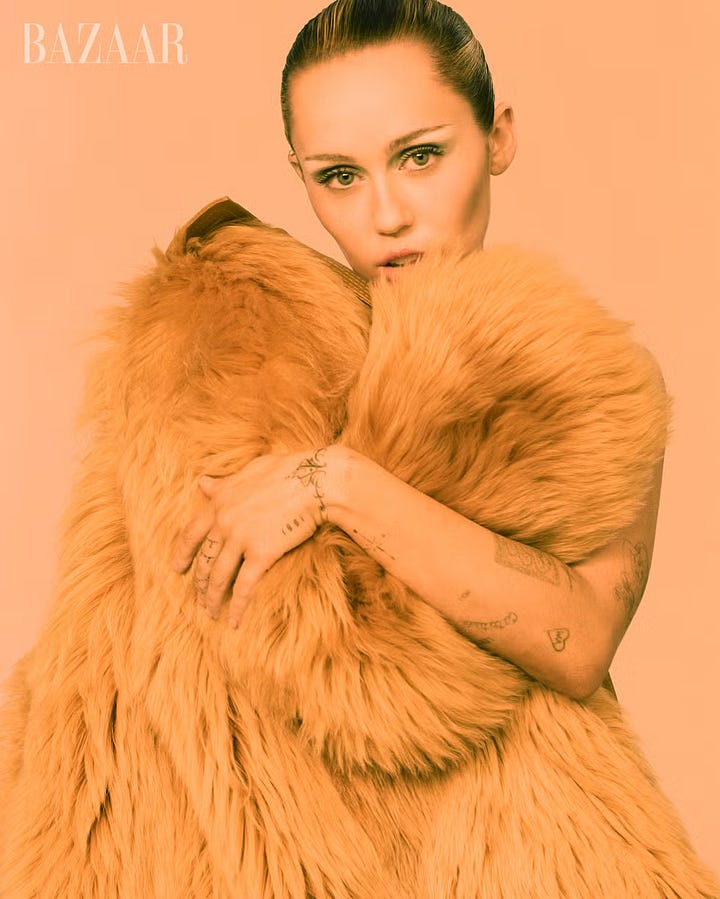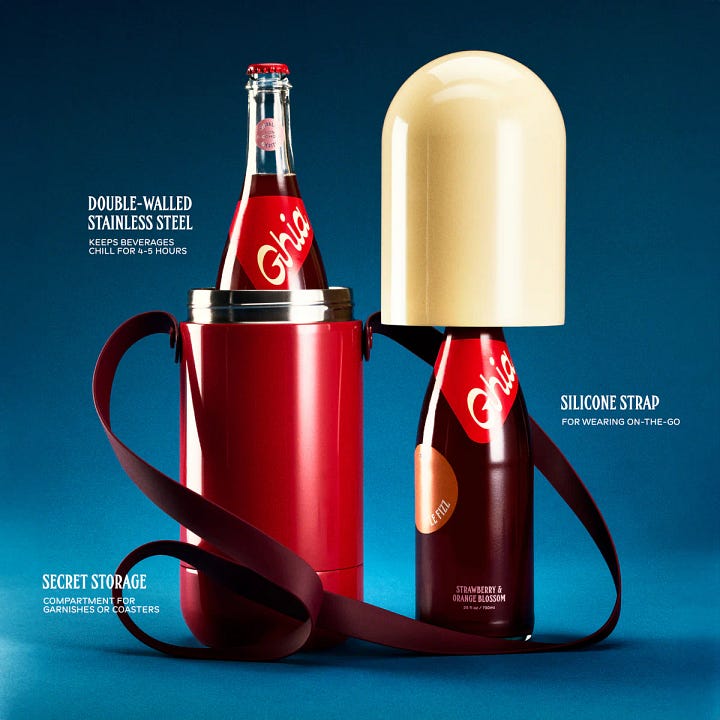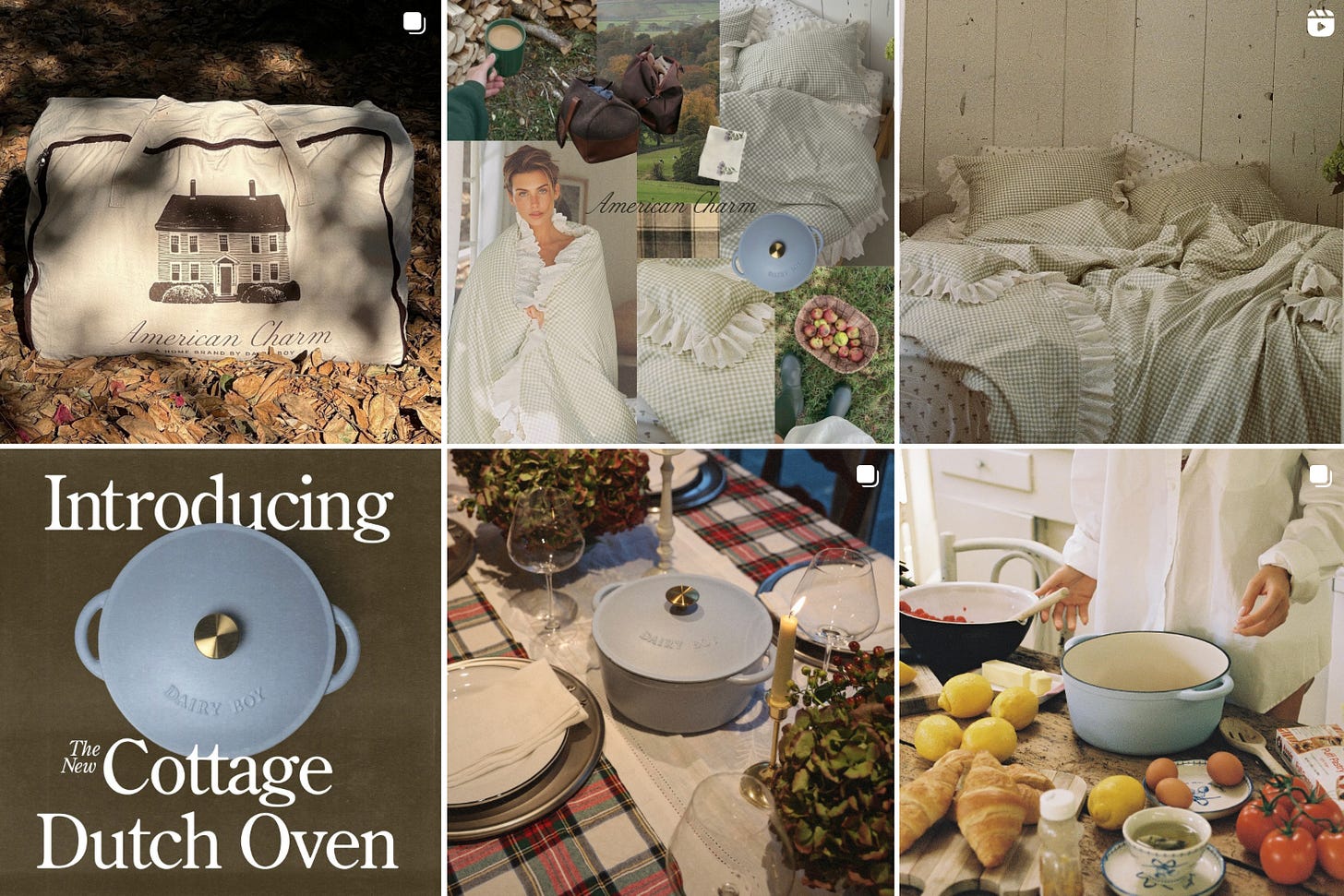“functional fragrance” as a concept deserves jail time
just a short stint
QUICK HITS
Instagram will soon let you reset your recommendation algorithm
Comcast Greenlights $7 billion spinoff of NBCUniversal cable channels
Because I write this newsletter, I read a lot of magazine cover stories like this Miley Cyrus one for Harper's Bazaar. Always, I’m hoping for something new or interesting to latch on to. Mostly, I’m left disappointed. These days I’m wondering, what’s it all for? Do people even care anymore? I asked a few of my very online Gen Z friends if they paid any attention to this stuff—all said no, except the media people, who are literally paid to care. I find it mildly tragic how once invaluable media assets like the magazine cover now have these glaring question marks haunting them, their value so intangible they might as well not exist. Back in September, Charli XCX was the cover star for at least three big publications, each celebrating a moment the culture had already been steeped in for months. Some of those cover images were iconic, but no more than Charli for Skims or acne or Converse. Certainly no more than whatever she posts on her socials on any given day. So if the internet can now turn anything into a cover image, and individuals have as much reach as publications, what’s it all for?


When I say corporate executives want to be more like Trump and less like Kamala, I hope you understand what I mean—they want to capture the imagination of the American people, play the media game right, and hopefully influence policy along the way. Last week, I shared a new Pew report which showed that almost 4 in 10 American adults under 30 get their news from influencers, the most popular of whom are conservative men. So, when PR firms like Edelman and the Brunswick Group publish guides to “News Influencers” on their websites, and Semafor reports that, yes, companies are now including these “business-friendly” podcasts and YouTube shows in their PR plans right alongside the Bloombergs and WSJs of the world, I’m not surprised. America’s C-Suite wants what Trump is having, and cultural influence is right at the top of that list.
Saturday night, I stayed up until 5 a.m., not because I was out somewhere doing something, but because I was in bed binge-watching The Day of the Jackal with my best friend. We watched all six episodes in a row and agreed this might be the best thing on TV right now, filling that True Detective Season 1-sized hole in our eager hearts. I read today that Frederick Forsyth, the author of the novel the show is based on, sold the film rights for just $25,000 back in the ’70s and will get nothing from Peacock’s $126 million adaptation. Isn’t that sad? It made me sad. Although I suppose that was a pretty neat check at the time.
I never totally understood why Netflix launched a popcorn line, and I don’t totally understand why A24 is now in the concessions business. All roads lead to CPG? Who knows. Still, it made me take a gander at A24’s website, and now I’m wondering how big their merch business is. I’d really love to know; they have a lot on there—a coffee table book for almost every movie, A24-branded fleeces, puzzles, ceramics! I keep telling you, all roads lead to lifestyle.
Speaking of paraphernalia, Ghia partnered with Coming Soon on a limited-edition travel cooler they’re calling Le Pill. How fun. I recently came to the conclusion that as a consumer, there is very little I need that doesn’t already exist. The problems have been solved; the jobs have been done. Most improvements are incremental, often negligible, and you’d be hard-pressed to find a hole in any consumer market that hasn’t already been filled. So, when it comes to consumer products—from beauty to beverage to technology—I want things that excite me; that are fun or funny or personality enhancing. This is why everything requires “lore” now. Because, let’s be honest, no one needs any of this stuff. We’re in an age of consumer frivolity, where the brands who understand fun will win.


McDonald's is bringing back the McRib sandwich along with a $19.99 half-gallon jug of McRib sauce, to help you forget about their recent E. coli breakout. They’re also investing $100 million to recover from the sales hit and help franchises, including $35 million in marketing to fund a national ad campaign through the end of the year. There’s nothing a big ol’ budget can’t fix.
I have a strange relationship with generational discourse. On one hand, I think most of it is ridiculous and find the way Gen Z is discussed as a monolith to be very jarring. But on the other hand, it is kind of fun, and it’s sometimes true, and it’s usually not that deep, so here and there, I will indulge. But then I see things like this: a Morning Consult report declaring the decline of honesty in younger generations. Apparently, 94% of boomers value honesty and authenticity, compared to 87% of Gen Z. Each generation values honesty less! Women, married couples, suburbanites, and high earners value honesty at higher rates! Those who don’t value honesty seek external validation, and the decline of honesty creates a dangerous environment for brands! It bothers me because I know that some well-meaning middle manager will file this under “Gen Z Insights,” no questions asked. I think we need to find new ways to interpret and understand data. I also think popular culture’s co-opting of brand speak (since we’re all brands or marketers now) is part of why this kind of generational discourse is so pervasive. But like I said, it’s probably not that deep.
That infamous duct tape banana sold for $6.2 million at a Sotheby’s auction last week. When asked why he bought it, crypto entrepreneur Justin Sun said, “I found out about Comedian a month ago, and I loved the idea. It echoes our idea of decentralization in the crypto world, because this is a conceptual artwork—it’s impossible for you to destroy the artwork itself.” He plans to display it in his Hong Kong home but is willing to loan it to “serious players” in the industry. He added, “If Elon Musk wants it, I’ll let him put it on the spaceship to Mars.”
Saie’s first-ever IRL office looks a lot like the rhode office, which looks a lot like the Beis office, which I’m sure resembles many Instagram-worthy consumer brand offices. They’re all very lovely, of course.
HarperCollins reached a deal with Microsoft allowing the tech company to train its AI model using select nonfiction titles. A source told Bloomberg the content won’t be used to generate material without human authors, and since high earners value honesty at a higher rate, I’m going to pretend I believe this. Paul Graham recently published an essay called Writes and Writes-Nots, predicting that AI will drastically reduce the number of people who can write in a few decades: “The result will be a world divided into writes and write-nots. There will still be some people who can write. Some of us like it. But the middle ground between those who are good at writing and those who can't write at all will disappear. Instead of good writers, ok writers, and people who can't write, there will just be good writers and people who can't write.” Tragic.
According to Business of Fashion, those who can no longer afford luxury handbags are repurposing designer makeup bags as clutches. Apparently, sales of makeup bags are “booming,” but no data was provided, so I can’t say for sure.
I’m newly enamored with Paige Lorenz’s lifestyle brand, Dairy Boy, and its sister homeware label, American Charm. Paige was ahead of her time, wasn’t she? I expect to see many more brands leaning into the Americana aesthetic in the next few years, and along with that, the serif fonts of prairies and Westerns will reign supreme. I hinted at this a few weeks ago—the return of the serif font—and many of you were curious about my theory. I think sans serif was a moment that many brands leaned into because it represented a kind of aspirational modernity that characterized the last few years. Serif has always felt more classic and traditional—cottage core, horse girls, and coastal grandmas—the America of many people’s dreams. Brands will respond, new brands will pop up, but nothing as ubiquitous as what we saw in previous generations because culture, audiences, and tastes are more fragmented than ever. When I think of GLP-1s, I picture them in serif, and if you can’t see what I’m saying, I fear you never will.
Paris Hilton is one of those celebrities whose persistent cultural relevance eludes my understanding. I enjoy her in an easy, noncommittal way, but I’ve never understood who 2024 Paris Hilton is for. Who are her superfans? Last week, she announced 11:11 Beauty, a new skincare line in partnership with Guthy-Renker, the company behind JLo Beauty, Westmore Beauty, and Cindy Crawford’s Meaningful Beauty. (Doesn’t sound promising). And so I went down a rabbit hole. Paris launched her media company, 11:11, in 2021 without outside funding. This year, it expects to earn around $50 million in revenue with more than a 50% profit margin. 11:11 Beauty is just one of the many joint ventures operating under the company’s umbrella—in May, they partnered with HappyNest Entertainment and 9 Story Media Group to launch a digital series catered to kids and families called Paris & Pups, with original music by Paris. 11:11 Media, the company's production firm, launched a metaverse experience called Slivingland on Roblox last year and has an ongoing partnership with iHeartMedia to produce a range of podcasts spanning documentary style series related to Hilton's youth impact work to a podcast about the history of the world's greatest nightclubs. Paris is always launching music—her latest single is called ADHD—and I swear she always has some licensing deal going on. 11:11 co-founder and president Bruce Gersh told Axios, “Paris is our Mickey Mouse, and we’re hopefully the next Disney.” I think what Paris does works because although I may not know who her audience is, she clearly does. She’s playing a different kind of influencer game, sacrificing coolness for commerciality, and it feels very her. I respect it.
Between the both of us, I think whoever came up with the idea to market perfumes as “functional fragrances” deserves jail time. Just a short stint. The other day,
posted a note calling out Nue Co’s questionable branding. The company re-released their original Functional Fragrance collection, describing them as “fragrance supplements” crafted to help you ease stress or improve focus. The announcement post included a single review, which implied that one of the scents, Forest Lungs, had helped a customer with their alcoholism. “... I reached for the bottle of Forest Lungs, sprayed it on my wrists, and inhaled deeply. I immediately felt more serene with a glimmer of hope. Today is day ten alcohol-free and I always have my Forest Lungs close at hand.” To feature that single product review in a launch post is to make a very strong claim without saying anything at all, which is a pretty wild thing to do.And then you have Seed, which launched a toilet stool (aka Defecation Postural Modification Devices), and is doing the most to make it make sense. “Biohack” is Ochuko’s worst word of 2024. Makes me want to sue people.
The Atlantic recently announced a new section and newsletter called Being Human, part of its expanded focus on health reporting. The column launched with new reporting on the BRCA gene needing a rebrand, how the broad support for vaccines in America may be tested by the incoming Trump administration, and the way people are thinking about deodorant all wrong, from Yasmin Tayag. With RFK Jr. positioned to become America’s “Wellness Influencer-in-Chief,” I’m looking forward to seeing how both legacy and independent media cover health and wellness in the coming years. Tyhings are going to get more contention than ever, as topics like longevity, the Ozempiconomy, vaccines, status foods, big pharma, and big CPG converge in fascinating ways. I asked
who writes Plant Based, how she thought the health and wellness discourse will change in the next four years: “Traditional media has already started to expand their wellness coverage, but not quickly enough, in my opinion, to mirror the industry's boom over the past 5 or so years. We're going to continue to see it grow, and now that RFK Jr. will be a recurring character, I hope it'll light a fire under these publications' asses to prioritize contributions from experts and well-researched projects. That being said, I know it's an unrealistic ask considering the current state of media... “Macy’s is delaying its earnings report after discovering that a single employee had misstated up to $154 million in delivery expenses over the past few years. Embarrassing for everyone involved.
Hallie Batchelder’s new podcast for Alex Cooper’s Unwell Network looks like it’s going to be fun… and dirty. The network currently has five shows, with some performing far better than others. The new podcast, Extra Dirty, seems like a return to form for the Unwell brand, following Hallie as she exposes “every inch of her being” for our “personal enjoyment”—very much in line with OG Call Her Daddy and Hot Mess, the network’s most successful shows.
Then suddenly, everyone wanted to know who Lindsay Lohan’s face doctor was.






in terms of your first link - magazines need to let writers be a little mean again! I loved reading celebrity profiles from people like taffy brodesser-akner and caity weaver because we got beautiful editorial pics WITH the author's genuine (and funny!) opinion about the subject. these days profiles seem to be one more toothless brand extension of a celebrity, instead of an interesting analysis of their persona + celebrity culture at large
What the fuck is that Harper Collins AI deal??!!?!!?! This newsletter keeps giving such depressing publishing news (in a good way. good work keep it up it’s not your fault the publishing industry is going down the toilet. xoxox)